State of the economy: September 2019
Report produced tri-annually by the Chief Economic Adviser to provide a picture of the Scottish economy in an international context.
This document is part of a collection
Scottish Economy Update
Gross Domestic Product
The first half of 2019 has presented a mixed picture for Scotland's economic output which reflects a combination of Brexit uncertainty and a weakening in the wider UK and global economic environment.
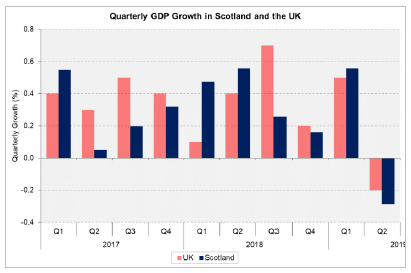
The latest GDP data for Q2 2019[1], provides insight into how Scotland's onshore economy performed in the 3-months following the original UK EU departure date at the end of March.
Over this period, the Scottish economy contracted by -0.3%, broadly in line with the UK economy as a whole which contracted by -0.2%. The key driver of the contraction was in the production sector (-1.1%), which alongside a contraction in the construction sector (-2.2%), more than offset marginal growth in the services sector (0.1%).
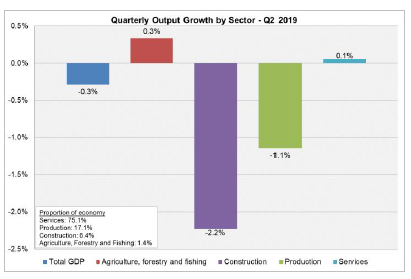
Over the year as a whole, the Scottish economy continued to grow 0.7%, however this was notably slower than annual growth of 1.5% in the first quarter of the year.
Service sector growth has slowed through the first half of 2019 compared to 2018, as it has in the UK as a whole, with Business Services and Finance slowing to 0.3% quarterly growth. Output growth from Distribution, Hotels and Catering (0.3%) and Transport, Storage and Communications (0.6%) picked up over the second quarter, however this was offset by a fall in output from Government and other Services (-0.5%).
The contraction in Q2 followed relatively robust growth of 0.6% in the first quarter. Around half of that growth came from the manufacturing of Spirits and Wines and Pharmaceuticals as firms stockpiled and moved to complete orders prior to the original Brexit deadline. The June edition of State of the Economy, set out that these specific drivers were likely to be temporary as firms would subsequently unwind their stock levels.
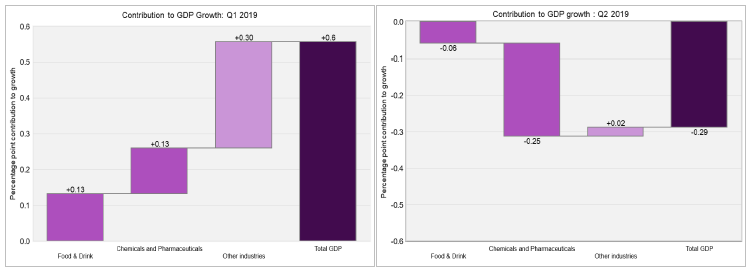
The output data for Q2 shows that the same two manufacturing sectors that contributed most strongly to growth in the first quarter, contributed mostly to the subsequent fall in output in the second quarter and likely reflects the unwinding of stocks built up in Q1. This pattern of economic activity mirrors the findings from economic modelling presented in the October 2018 edition of State of the Economy[2]: the additional stockpiling in 2018-19 boosts growth initially but comes at a cost of growth in 2019-20 as companies allow their inventories to unwind.
The uncertainty regarding the nature and timing of the UK's EU departure is likely to continue generating volatility in the data. The response of businesses to the current October deadline may differ from the original Brexit deadline in March as the same sectors may not respond in the same way and may not stockpile again to the same extent. For example, the start of the festive trading period will impact firms' ability to prepare and stockpile for Brexit, while the ongoing uncertainty may reduce the willingness of firms' to incur the same degree of costs as in March.
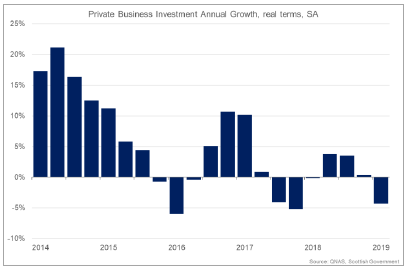
The impact of prolonged uncertainty is considered in more detail in the box below. To set the context, the recent trend in private business investment is shown.
Estimating the impact of prolonged uncertainty from Brexit on the Scottish economy
In a previous State of the Economy Report in January 2018, we examined the impact that heightened levels of uncertainty from Brexit might have on the Scottish economy, in particular on business investment.
With uncertainty from Brexit now persisting, both around an EU Exit date and the form of future economic partnership with the EU, we estimate the impact that this prolonged period of uncertainty could have on the Scottish economy.
In our earlier analysis, the period of heightened uncertainty ran until the end of the second quarter in 2019. We now extend this period of uncertainty to persist until the end of the first quarter of 2020. In all other respects, the modelling approach is the same as in the previous analysis.[3]
The results show that the additional impact of this prolonged period of uncertainty is estimated to have reduced or deferred the level of business investment in Scotland by a further £0.5 billion by the start of 2020-21 than previously estimated.
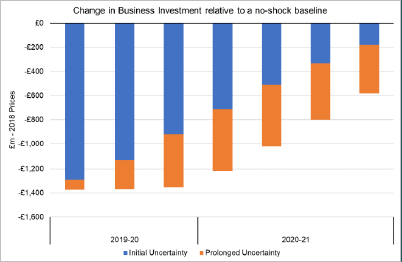
One of the main consequences of this lower or deferred business investment is that it reduces the stock of capital in the Scottish economy – for example, office buildings, new factories or manufacturing equipment.
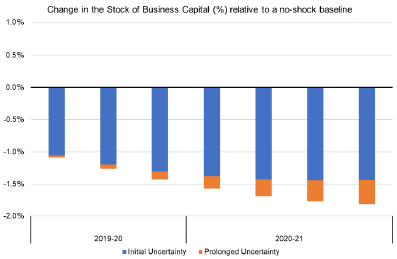
The conclusion is that the prolonged period of uncertainty will have a more severe impact on business investment than previously estimated in the short term. In turn this is impeding growth of the capital stock by more than previously estimated and risks raising longer term challenges for productivity and growth in Scotland.
Retail Sales
Retail sales growth has supported service sector growth in the first half of 2019.
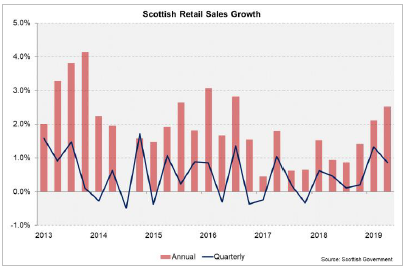
Over this period, there has been generally stronger growth in Scottish retail sales compared to the past two years.[4] However, the pace of growth slightly softened in Q2 2019, growing 0.9% over the quarter (2.5% annually), down from 1.3% growth in Q1 2019. This broadly reflected the movement in retail sales across Great Britain as a whole where growth slowed to 0.7% over the quarter.
The latest data suggest that retail sales have held up despite Brexit uncertainty. However trading conditions remain challenging for the sector with retail footfall in Scottish town and city centre locations continuing to fall into the summer months.
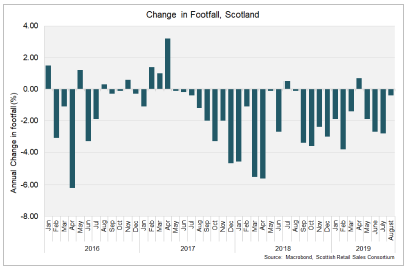
While this has been driven by well documented structural changes in consumer behaviour, in particular the growth of online retail, this has implications for the profitability of many high street retailers. As such, Brexit uncertainty remains a key challenge for the sector and the ability of retailers to respond to any downturn in sales, or disruption to supply chains, as a result of continued Brexit related uncertainties.
Exports
The international trade environment has weakened and, as set out on page 2 above, has become more uncertain in 2019 amid ongoing trade tensions between China and the United States and a softening in global growth and trade over the past year.
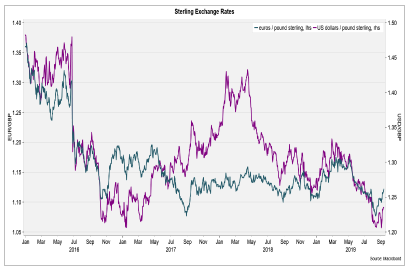
Alongside this, Brexit uncertainty has continued to contribute to currency fluctuations with Sterling depreciating against the dollar and euro over the course of the year. The box below considers in more detail the relative impact that currency movements have on import and export growth.
In Q1 2019, Scotland's manufactured exports[5] grew by 1.4% over the quarter and 3.3% over the year; slightly slower than at the end of 2018. The largest contributor to the increase in the volume of manufactured exports was Food and Drink exports which increased 5.7% over the quarter and 16.9% over the year. Refined petroleum, chemical and pharmaceutical product exports also increased over the year (3.3%), while there was a fall in exports of engineering, machinery and metals (-6.9%) and other manufactured products (-4.3%).
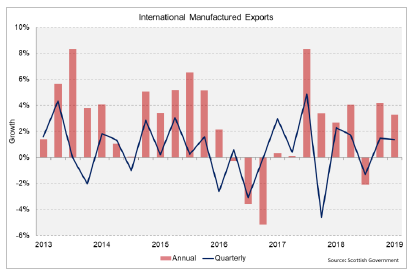
More recent data from HMRC[6], a separate export survey, show that Scotland's goods exports (including oil and gas) increased in cash terms by £4.3 billion (14.5%) to £34.0 billion over the year to June 2019, compared to the previous year. This increase was driven by a rise in oil and gas exports, which to the EU increased by 25.8 percent to £9.4 billion and to non-EU countries more than doubled to £4.4 billion.
Exchange Rate Depreciation and the Trade Balance
Since the EU referendum, Sterling has depreciated by around 15% against the Euro and 17% against the dollar. Over that period, Sterling has been highly sensitive to Brexit signals and most recently the prospects of a no-deal.
Currency depreciations are usually expected to increase exports and hence to improve the trade balance. However, recent research by the IMF[7] shows that currency depreciation may lead to only a modest increase in exports, with improvement in a country's trade balance potentially driven by a reduction in imports.
This box explores this issue further for Scotland by undertaking the following analysis and modelling:
First, we present outturn data on Scotland's exports and imports and trade balance in the period since the EU referendum (2016 Q3). These are sourced from the Quarterly National Accounts Scotland (QNAS). Figure 1 shows what happened to exports and imports following the currency depreciation.
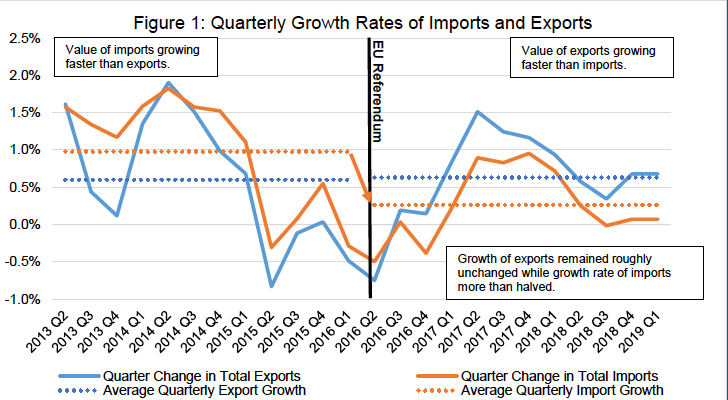
Second, we model[8] what could have happened to the trade balance if the depreciation in Sterling had not occurred. This is done by holding the exchange rate at the 2015 Q4 pound to dollar rate until 2019 Q1.[9] Figure 2 shows what exports, imports and net trade might have looked like without the currency depreciation.
By comparing the two sets of figures we can illustrate how the trade balance has been affected by the currency depreciation.
Figure 1 above plots quarterly growth rates of exports and imports from QNAS data. Since the EU referendum result and the fall in the Sterling exchange rate, Scotland's net trade balance has improved. Whilst exports have remained at approximately the same rate of growth, the rate of growth of imports has fallen resulting in an improvement of the trade balance. This suggests that imports have been relatively more sensitive to changes in the exchange rate than exports.
The fall in the value of Sterling following the EU referendum could be interpreted as one sign of wider political and economic uncertainty in the UK. The modelling considers only what might have happened in the absence of a currency depreciation - it does not attempt to show the impact of removing any wider uncertainty that has occurred since the EU referendum.
Nevertheless, the analysis supports the view that the improvement in net trade from the currency depreciation has been driven more by a fall in imports than by a rise in exports.
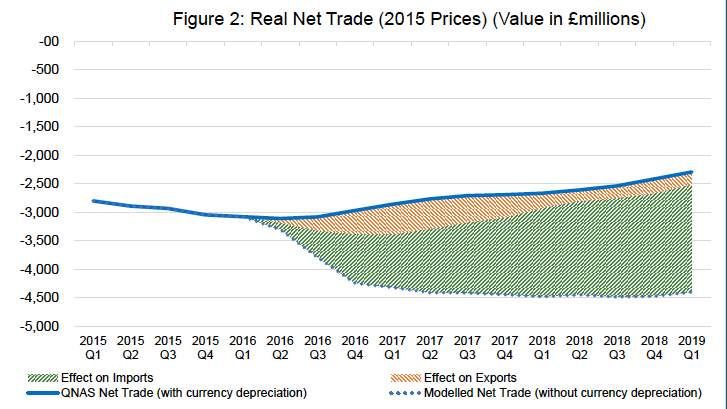
Labour Market
Scotland's labour market has continued to perform strongly by historical standards in 2019, however has softened slightly from the record performances in employment and unemployment achieved in 2018 and start of 2019.
Latest data for May to July 2019[10] show that while the unemployment rate remains lower compared to last year and compared to historical levels, it rose from 3.3% to 4.0% over the quarter.
| Scotland Labour Market Statistics (May-July 2019) | |||
|---|---|---|---|
| Rates | Latest (%) | Quarterly Change (% p.t.) | Annual Change (% p.t.) |
| Employment* | 74.9 | -1.0 | -0.1 |
| ILO Unemployment** | 4.0 | 0.7 | -0.1 |
| Economic Inactivity* | 21.9 | 0.4 | 0.2 |
| Levels ('000) | Latest | Quarterly Change | Annual Change |
| Employment (16+) | 2,669 | -33 | 8 |
| ILO Unemployment (16+) | 110 | 19 | -3 |
| Economic Inactivity (16-64) | 754 | 14 | 5 |
*Denominator = Working age population (16-64)
**Denominator = Total economically active
Alongside this, the level of employment has increased by 8,000 over the year, however fell by 33,000 over the quarter with the employment rate falling to 74.9%.
The rise in employment over the year was driven by an increase in full time workers (47,000) which more than offset a fall in part-time workers (-40,000).
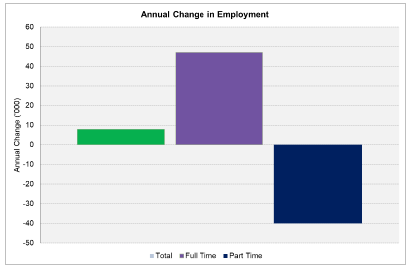
Inactivity in Scotland – those neither in work or looking for work – has increased over the quarter and the year to 21.9%.
The slight softening in the labour market has also been reflected in business surveys[11], with firms reporting that permanent vacancy growth has eased in recent months to its lowest rate in over three-and-a-half-years, while temporary vacancies have increased. This recent shift towards temporary work may be for a variety of reasons including business uncertainty and the low cost of labour relative to capital. Businesses may also be hiring on a temporary basis given Brexit uncertainty.
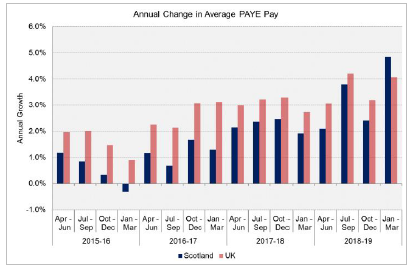
Despite a softer labour market, earnings growth has strengthened at the start of 2019. HMRC data for Scotland[12] show that average nominal PAYE pay in January-March 2019 was 4.8% higher than a year earlier, however real terms growth remains relatively subdued.
Labour Productivity
Labour productivity in Scotland has continued its recent pattern of positive growth at the start of 2019, albeit at a slower pace than in 2018.
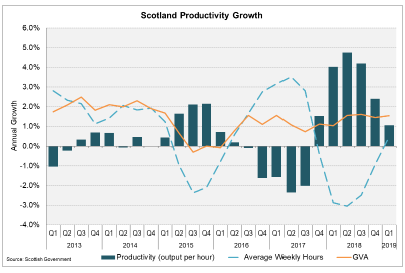
In Q1 2019[13], labour productivity (output per hour worked) grew 1.1% over the year, down from the average annual growth rate of 3.8% during 2018.
Positive productivity growth reflects that output is growing more quickly than hours worked. The slower pace of productivity growth at the start of 2019 reflects that annual output growth has remained stable at around 1.5%, while growth in average weekly hours worked has strengthened, rebounding to 0.5% growth over the year following five consecutive quarters of contraction. This may reflect the increase in full-time employment relative to part-time employment over the past year.
Business Sentiment
Business and consumer sentiment data provide useful insight as leading indicators into the confidence and optimism of firms and households and how that may influence their economic activity in the short term.
The latest RBS Purchasing Managers Index survey for August 2019[14] reported that while businesses expect output to increase over the coming year, the degree of business confidence across both the manufacturing and service sectors has fallen to its lowest level in over 3-years.
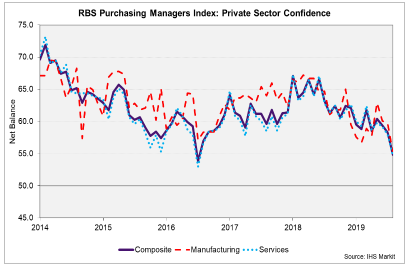
The weakening in sentiment over the past year is also signalled in the engineering sector[15] in which optimism in August 2019 was reported as negative for the first time since 2016. The Scottish Chambers of Commerce Quarterly Economic Indicator[16] showed that while business optimism was positive across the sectors in Q2 2019, it was generally lower than the same period last year.
The fall in business confidence reflects in part the political and economic uncertainty associated with Brexit, which during the first half of 2019, has weighed on business investment and led to resources being diverted to short term stockpiling. Due to the prolonged period of uncertainty, this is likely to continue impacting business sentiment and investment intentions. In their latest Inflation Report[17], the Bank of England noted that UK underlying output growth is projected to be subdued in the near term reflecting more entrenched Brexit uncertainties.
The fall in business sentiment is also consistent with other factors that have been raised in latest business surveys such as weaker growth in business activity and output, weaker growth in new orders and exchange rate fluctuations feeding through to input cost increases.
These factors, alongside stronger external headwinds, suggest a changing economic environment in which firms will be considering future investment and contingency planning ahead of the next Brexit withdrawal deadline.
Consumer Sentiment[18]
As with business sentiment, consumer sentiment in Scotland has remained weak in the first half of 2019. Having fallen to its lowest level in the time series in Q1, latest data shows consumer sentiment improved in the second quarter rising 3.4 points from -9.6 to -6.1. However the fact that the reading remains negative shows that more respondents continue to report a decline in sentiment than an improvement, as has been the case since Q3 2016.
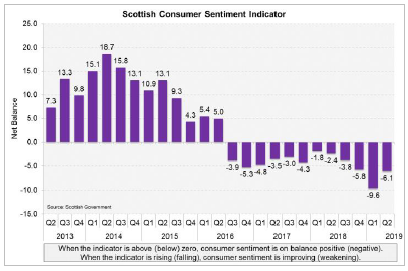
Of the five elements that make up the Consumer Sentiment Indicator, respondents continue to be most pessimistic about the outlook for the Scottish economy over the coming year (-18.6). Alongside this, respondents continue to be most positive about the outlook for their personal household financial security which, on balance, they expect to improve (3.9).
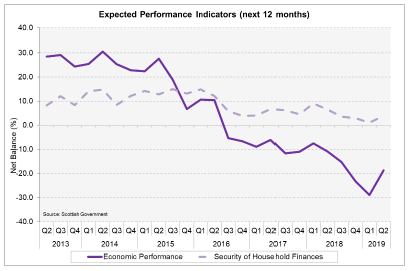
While both indicators improved compared to Q1 2019, both remain notably below their series averages. The weaknesses in the forward expectation indicators are likely to reflect a range of macroeconomic issues such as the ongoing uncertainty surrounding Brexit, personal job security, wage growth and so on.
Looking ahead, the weakness in consumer sentiment presents a downside risk to the economic outlook as expectations may start to impact on real economic activity.
Scotland's Economic Outlook
The Scottish economy is forecast to grow in 2019, however as with the UK and global economic outlook, the pace of growth is generally expected to be slower than last year (1.4%).
While the forecasts (where applicable) implicitly reflect the impacts of Brexit uncertainty so far on outturn data, they continue to assume some form of orderly Brexit transition, which would support a pickup in growth from 2020 onwards.
However, as we've set out in this report, the ongoing uncertainty arising from when and how the UK withdraws from the EU will continue to impact consumers and businesses sentiment and activity. Companies will continue having to divert resources to contingency planning and stockpiling rather than business growth and investment.
Until a Withdrawal Agreement is ratified or an extension is agreed, the economic risks associated with a No Deal Brexit remain live. As has been highlighted in Scottish Government Analysis, No Deal Brexit – Economic Implications for Scotland[19], such an outcome risks pushing the Scottish economy into recession with a corresponding sharp rise in unemployment.
For the UK as a whole, the recent Fiscal Risks report from the OBR suggests that the UK economy could contract through 2020 by around 1.4 per cent based on their most recent assessment, whilst the Bank of England suggest output lost to the economy could be as much as 5.5 per cent in the advent of a No Deal Brexit with a rise in unemployment to 7%.[20],[21] The Fraser of Allander Institute reported that applying the Bank of England's scenario to Scotland could result in GDP in Scotland being £9 billion lower and unemployment rising to nearly double the current rate.[22] However, it is also the uncertainty over the nature of the UK and Scotland's long term relationship with the EU that persists.
The table below sets out a selection of independent forecasts and projections which, given their range in the short term, highlights the uncertainty of forecasting at this time.
| Independent Scottish GDP Growth Forecasts (%)[23] | ||||||
|---|---|---|---|---|---|---|
| 2019 | 2020 | 2021 | 2022 | 2023 | 2024 | |
| Scottish Fiscal Commission | 0.8 | 0.9 | 1.1 | 1.2 | 1.3 | 1.3 |
| Fraser of Allander Institute | 1.2 | 1.4 | 1.5 | - | - | - |
| EY ITEM Club | 1.0 | 1.4 | 1.5 | 1.7 | 1.8 | - |
| PWC | 1.6 | 1.3 | - | - | - | - |
Alongside domestic challenges, external headwinds have also strengthened in 2019. Global growth is forecast to slow this year and the ongoing global challenges arising from trade tensions and heightened trade uncertainty, means that the external trading environment has softened relative to the last couple of years. Alongside Brexit uncertainty, these present a downside risk to the Scottish economic outlook.
Contact
Email: OCEABusiness@gov.scot
There is a problem
Thanks for your feedback